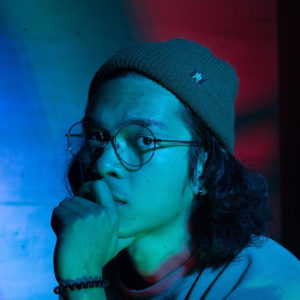Bio

Christopher Dela Cruz is a Filipino-Canadian artist whose works investigate the relationships of objects and technology, to interculturalism and individuality. His primary media of works revolve around sound, sculpture, installation, and digital media. His works have been exhibited in the Museum of Contemporary Art, Nuit Blanche Toronto, Doris McCarthy Gallery, and in various public and private galleries and festivals. He was recently awarded the Ontario Regional Prize for "Notice of Disruption" for the BMO 1st Art! Competition in 2019. He currently lives and works in Toronto as the Audio Director of “Festival Italiano di Johnny Lombardi” at CHIN Radio/TV International, and a Technician for the Department of Arts, Culture, Media in the University of Toronto Scarborough Campus.
Questionaire
Why did you get involved in this project?
The period of COVD-19 heavily impacted the way I created work. The community that helped fuel my drive to create suddenly retreated in isolation to help mitigate our current circumstances. It was, and currently still is, imperative that we physically distance ourselves – but it was hurtful for the arts that relied on shared spaces, gatherings, and events. Being involved in this project meant that I had to re-adapt to a new environment and be involved in building a new community. It made me feel the rush of creating work again – that now lives on a different space and contributes to something bigger than I am.
Did the one week turn-around for the work help or hinder your creativity?
Short turnarounds are typically conducive to my process; a little pressure is usually necessary to foster creativity.
How did you feel about working on a project where you didn’t know who you were collaborating with?
There is something special about creating something and knowing that somebody will build on or expand it. It’s sort of comparable to the way I consider the work of great artists over the years as steppingstones to make greater works. It’s that feeling of adding my signatures on others’, and theirs on mine. It’s the (blind) collaboration that was great for building up excitement and dissolving any expectations. Even though you could not identify who you were working with, you can identify them through their contributions. The works produced then becomes something separate from what you thought it would be and became what everybody wanted it to be. And I think that is quite remarkable.
Has being involved in the project changed your thoughts on creativity?
I don’t think that I ever had a solid statement on thinking about creativity, and being involved in this project only perpetuated the aspect of its ability to always surprise me.
If you worked on several videos, what kept you coming back for more and how many did you do?
Every way of contributing to this project is something that required me to brush up on what I was easily able to do before COVID-19 – with limited (and vastly different) resources. It was a challenge that was good for exploring new ways of making and was fundamentally generating a refinement on my process. As somebody that has been sharing a studio space (and no longer have access to it during this time) I have taken for granted the resources that was readily available to use for my work, and I think that it was a good way to reinforce the sentiment that it should never be about the tools that I have. It should be about how I use them.